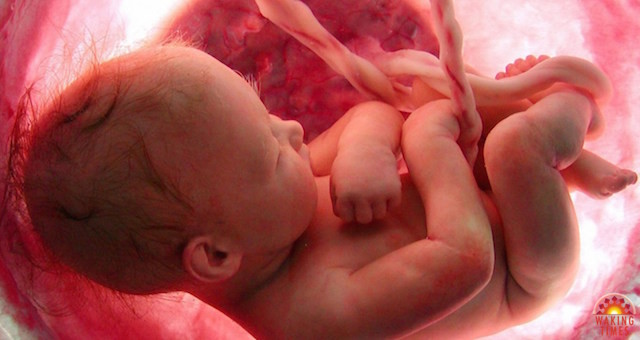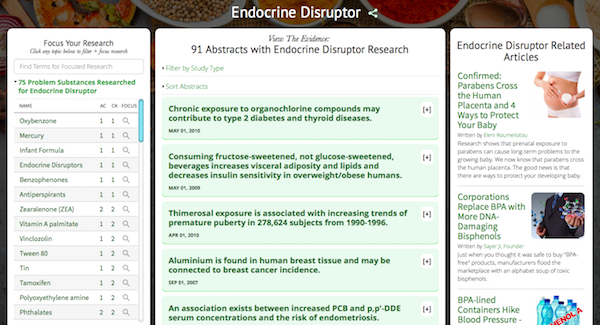Written By: Dr. Melody Milam Potter
Male births have been in decline for decades, while researchers say developmental genital damage from chemical exposure can become hereditable.
Endocrine Disruptors Sabotage the Male Fetus
In the dark warmth of the womb, a miracle unfolds silently and inexorably. An unrecognizable glom of cells begins to take shape according to a master plan laid down eons ago. The tiny mass that will soon form a priceless treasure burgeons into human form with fingers, toes, and a minuscule nose. It is female, and only nature can read the instructions that determine whether the being remains female or transforms into a male.
The evolution of this minute universe parallels that of our immeasurable one, a big bang followed by unceasing organization of shape and form using the impetus of that force. Whether our boundless universe has proceeded according to plan may be a theoretic issue. Whether this tiny universe follows its own plan is a chemical one.
Where are the Boys?
As early as April of 1998, the Journal of the American Medical Association quietly released a special report that revealed puzzling news. The number of males born in industrialized nations has dropped dramatically since 1970, constituting a serious reversal in earlier trends. Records up to 2014 show that trend continuing.
Human male births have always held a marginal advantage, probably Nature’s way of insuring that enough of the somewhat more physically vulnerable male infants will survive. Earlier last century, between 1900 and 1950, typically as many as 106 males to every 100 female babies were born, probably because obstetrical practices improved so much that more male babies survived pregnancy and delivery. Census figures after 1970 indicate a trend reversal, a significant reduction in the number of little boys born. Today in industrialized nations, including Canada, the U.S.A., Sweden, and the Netherlands, that ratio has dropped significantly, a shift which over four decades translates to at least one male less in 1000 births or about 80,000-100,000 fewer males in a population as large as the U.S.A. Over the world that adds up significantly, creating a red flag for humanity.
Although in a population of 325 million, 80,000 seems like a drop in the proverbial bucket, the real mystery exists in what is happening to these little boys. While it may seem counter-intuitive, top environmental scientists say these little boys may be being born female.
This disturbing and unnatural alteration in sex ratio represents a potential threat to both our species survival and our cultural norms if the trend continues. And because scientists have identified a clear and reversible cause for this change, they have designated the shift a “sentinel health event,” a significant and preventable change in world health. The decline gives no hint of slowing; male numbers appear to be progressively decreasing in proportion to girls. The culprits? Synthetic chemicals pretending to be hormones, Endocrine Disrupting Chemicals (EDCs).
This revelation comes as no surprise to anyone who understands fetal development. Gonadal cells that build male and female sex organs proliferate more rapidly than most other cells, such as bone or muscle, in a developing fetus. And, according to Dr. Devra Davis, founder of the Environmental Health Trust, since rapidly dividing cells are more likely to “incorporate and replicate errors,” these fast growing sexual organs are extremely susceptible to synthetic chemicals capable of converting genetic boys into girls and feminizing male babies.
But how can a chemical change the sexual future of a human being? The answer lies in the fact that human sexual development depends on delicately balanced biochemical processes.
Turning Boys into Girls
Within six weeks of conception, the flourishing embryo, in an exuberant burst of life, grows a heart, mouth, limbs, eyes, muscles, a set of unisex gonads and two pairs of genital tubes, one male, one female. The next step is genital growth.
Near the close of the pregnancy’s second month, the baby starts developing sexual organs. Inherently poised to construct a little girl, the baby’s body begins executing the female program unless specifically interrupted by male hormonal cues which should be transmitted if the baby is genetically male. If no male instructions are forthcoming, the pea-sized embryo generates female organs, ignoring the child’s genetic blueprint for male (XY) or female (XX). The male tubes dissolve, leaving the female tubes to metamorphose, sprouting oviducts, fallopian tubes, uterus, and vagina. The gonads, neurally wired for either gender, flower into ovaries.
If, however, the baby is genetically male, with both an X and a Y chromosome, and all goes as planned, around day 51 the Y, or male designating chromosome, signals the gonad’s Sertoli cells to blast the female organs with an anti-feminine secretion called AFH. The object is halting female development so male construction can proceed. Under this barrage, the female ducts shrivel like abandoned fruit, almost disappearing within days. With these structures out of the way, the female volition is sapped, allowing the evolution of male sex organs from the androgynous gonads.
Once the gonads emerge as testes, these near microscopic male organs discharge the male hormone, testosterone, driving the cultivation of even more male features. Testosterone first directs the male ducts to build a bridge between the baby’s testes and ejaculatory duct, via a tube called the ductus deferens. Afterwards, testosterone action propels the testes into the scrotum, providing the baby with a full set of male equipment.
However, if anything obstructs the hormonal processes that destroy the female ducts or that trigger male development, male genitals will not form. Even if the baby possesses the male (Y) chromosome, he can become a phenotypic, or physical, female endowed with female genitalia and a feminine appearance. His body will be female, his genetics, male.
“This process [of male genitalia development] is induced by Mullerian Inhibiting Substance (MIS), which is produced by the pre-Sertoli cells of the early testis. In the presence of MIS and testosterone, the Mullerian duct regresses and the Wolffian duct differentiates into the vas deferens and epididymis; in their absence, the Wolffian duct regresses and the Mullerian duct develops into the oviduct, uterus, and upper vagina, resulting in a female phenotype.” [1][2][3]
Epigenetics of Male Genital Disruption
But what could block the male instructions programmed into XY chromosomes long before our ancestors stood on two feet? The answer is anything that affects the human hormones these sex chromosomes command.
Male genital construction depends upon sex, or steroid, hormones which mandate the male baby develop a penis and testicles. Since testosterone, estrogen, and AMH are all steroid hormones, anything that modifies levels of these hormones, can invert the normal sexual development of a male baby. EDCs which are structurally very similar to steroid hormones can subvert this process. Sexual inversion, or the failure to develop sexual organs, preference, or behaviors in accordance with one’s genetic sex, creates an incongruity in the baby’s sexual makeup when the hormone plan is corrupted.
Timing is crucial. Genital development transpires during critical phases in which the right hormone must hit the right place in the right proportions. Like a vehicle entering heavy traffic, a lack of power, an error in perception, or a timid driver, can create a disaster. However, once the hormonal hit is made, it is irreversible. Male anatomy is either initiated or diverted.
Synthetic chemicals can create these silent switches in Nature’s plan. EDCs we encounter every day can alter the sex hormone balance, preventing male genitals from growing properly. By suppressing testosterone or by enhancing or mimicking the female sex hormone, estrogen, they can undermine the natural testosterone messages surging through a growing fetus.
For instance, estrogen mimics like dioxin, a widespread pollutant and potent endocrine disruptor, can intercept and overcome a hormonal message from a male gene. Dioxin also acts as a testosterone flusher reducing male hormone concentrations so much that the male action may not be stimulated adequately. Testosterone suppressors like DDT can block testosterone’s position on a receptor. Hormone stimulators can intensify the action of a natural hormone so much that the system shuts down and refuses to receive a male “go ahead” signal.
In fact, research substantiates that exposure to EDCs at a crucial time can disrupt the entire genital sequence. Even a single tiny dose of dioxin fed to lab rats during genital differentiation disrupts sexual development in the male babies. But the effects are not limited to rats. We occasionally see examples in humans in real life.
The EDC Disaster
In the summer of 1976, a medicinal soap factory in the tiny northern township of Seveso, Italy, spewed a huge cloud of chemicals containing dioxin traces over 5 Italian towns. When a reaction container’s safety valve ruptured from the pressure of hot trichlorophenol, 736 persons living in the area of highest contamination evacuated their homes for over a year. An international medical team attended 4700 more from surrounding areas for the next decade.
Cleanup by plant owners and the Italian government took 8 years. Many homes were demolished and rebuilt outside boundaries of the contaminated zone. Bulldozers scraped up and removed tons of topsoil.
The accident changed the lives of people who worked at the plant or lived within the contaminated zone. The accident happened in the middle of the night and they knew nothing for 2 days. Then, their skin started burning. Many children developed blisters so severe they had to go to the hospital. Chickens and rabbits died, and the mayor warned citizens of the town not to even touch vegetables or fruits in their gardens.
Many left their homes while the chemical company cleaned the whole town. They abandoned their possessions since the poison covered everything. The doctors from the company advised pregnant women to have abortions because they feared the babies would be damaged.
For seven years after the accident, fertility rates for those suffering high exposure, dropped dramatically, and twice as many girls were born to those parents who did conceive. Between 1977 and 1984, of 74 children born of parents within closest range of the plant, 48 were female when, statistically, only 34 should have been. Parents with the highest chemical blood levels produced no male children at all. During this period some women produced girls, even when, in the father’s family, boys were the rule.
The medical team counted on seven years to mark a milestone for those exposed since they knew the body half-life of dioxin is seven years. Therefore, within seven years, dioxin body burdens were expected to drop by at least one-half. They were correct. In fact, during the decade following that first seven years, affected citizens began producing normal numbers of male children again.
Testicular Dysgenesis Syndrome and EDCs
The Seveso incident, obviously, is an extreme example, but it glaringly demonstrates what goes on at a upper level while suggesting concerns for reduced exposure. The consequences of chemical exposure at a lower level sometimes seems to follow a U-shaped function with highest levels and lowest levels having greater effects than moderate ones, while others appear to be dose-dependent with higher doses having more effects than lower doses.
EDC exposure, at various levels depending on the chemical, may allow male genitalia to form but disrupt its design. While this is difficult to measure in humans because exposure is typically undocumented, high quality controlled studies in animals clearly show a connection with EDCs for hydrospadias, cryptorchidism, adult prostate cancer, anomalies of the epididymis, seminal vesicles, vas deferens, altered germ cells, and reduced sperm concentration and motility. Testicular dysgenesis syndrome appears to have its roots in the anti-androgenic role of EDCs like phthalates and pesticides. [4][5] Some male reproductive/sexual disorders appear at birth, others surface at puberty and, still others, like prostate cancer, later in adult life. The male reproductive tract is uniquely vulnerable and sensitive to the actions of endocrine disrupting toxins and exposure during fetal development and alterations can obviously affect a male throughout his life. As well, the male brain can be altered during periods while sexual preference, sexual appearance, and sexual expression/behavior develop. Mixtures of EDCs are significantly more disruptive to developing male genitalia than single exposures. [6]
“In addition, several other congenital disorders have been studied with an eye to the etiology of disease states: congenital adrenal hyperplasia, androgen insensitivity syndrome, Klinefelter syndrome, and hypothalamic hypogonadism may also result from chromosomal or genetic abnormalities or may be induced by chemical exposure during fetal development.” [1]
Some of these disorders may be passed on forever. “Persistent alterations in the epigenome” that occur with fetal exposure have been shown to be transgenerational over many generations in rats, with no observed decline in effect. [6]
These concerns should stimulate our society and the world in general to rebel against the present out-of-control chemical toxin production and use. Our money gives us the power to make changes in our environment. If we refuse to purchase toxin-containing materials, the chemical and pharmaceutical companies will respond by providing us with safer products we will buy. Our governments don’t even come close to providing safety from toxic materials either in industry, the work place, or in everyday life. Many of the EDCs to which we are regularly exposed have been grandfathered in “as safe” with no testing or evaluation by regulators. With all the scientific research accumulated on the destructive effects of EDCs, it seems unconscionable that authorities allow these activities to continue. To date, only a few EDCs have been banned and even then, for some, existing supplies can remain in use.
Many pregnant women work and live around EDCs daily with inadequate protection. For instance, a woman who works in a farm/garden store gets daily exposure to organophosphate pesticides, herbicides, fungicides. Chemicals used in plastics are ubiquitous since plastics exist everywhere and plastic substitutes (BPA-free, BPS, BPF) are as toxic as BPA. [8] Most women are unaware that when they walk in the park or through public buildings, or if they live downwind of a farm where growers used chemical pesticides, they are exposed to EDCs which pass on to their developing fetus. Since water treatment plants don’t generally test or control for estrogens, unfiltered tap water can be a significant source of excreted hormone pharmaceuticals and EDCs chemicals. [9] Estrogenic substances can actually increase as a result of a plant’s water treatment.
Common EDCs in Our Lives
An endocrine disruptor is defined as “an exogenous chemical, or mixture of chemicals, that interferes with any aspect of hormone action.” Examples of endocrine disruptors and their sources include, but are certainly not limited to:
*Synthetic pesticides and their breakdown products – organophosphates, organochlorines, carbamates, etc. used on farms, public buildings, neighbor’s gardens and lawns, (GMO products allow greater use of these chemicals)
*Chlorotriazines– herbicides used on farms, parks, golf courses
*Benzenes – solvents, sealants, laundry starch, scatter rugs, bathmats, lubricating oil, automotive
*Phthalates (plasticizers) – soft plastics
*BPA, BPS, BPF – plastics, canned foods and drinks, packaging
*PCBs – fire resistant coatings, plastics, electrical transformers/equipment
*Dioxins – released from chlorine processing and products, plastics, burning of chlorine products, chemical plants, transformers, bleaching
*Benzo(a)pyrene – cigarette smoke, coal tar, auto exhaust
*Pyrethrins and Permethrin – pesticides, flea and tick treatment for pets
*PBBs – background exposure
*Many solvents – cleaning products, lubrication
*Phenols – detergents, pesticides, spermicides, cosmetics, plastics, soaps, surfactants, latex paint, lubricating oils
*Styrenes – plastic production, floor waxes, polish, paints, putty, cleaners, varnish, tobacco smoke, automotive exhaust, food containers
*Furans – used to dissolve glues and plastics, paints, varnishes, textiles
*Metals like lead, cadmium, and mercury – paint, batteries, pigments, electroplating, mining, welding, electronics, dental, laboratory, furnaces, metal recovery, agriculture, production of chlorine and fluorescent lighting, temperature devices, fish including shark, king mackerel, swordfish and tilefish.
*Unfiltered tap water – can contain estrogen from excreted medically prescribed hormones, pesticides, and multiple other EDs
While it doesn’t make sense that a woman hide out in her bedroom during pregnancy, increasing her awareness of the sources of ED exposure could help protect her fetus from harm. Every effort she can make to reduce her exposure by keeping her home, where she spends most of her day, chemically reduced, avoiding chemically-polluted areas and activities, incorporating protection like air and water filters, and using safe, natural products, lowers her baby’s over-all risk.
For evidence-based research on endocrine disruptors, visit the GreenMedInfo.com Research Dashboard.
References
- Sarah Campion, Natasha Catlin, Nicholas Heger, Elizabeth V. McDonnell, Sara E. Pacheco, Camelia Saffarini, Moses A. Sandrof, and Kim Boekelheide. 2013. Male Reprotoxicity and Endocrine Disruption. Chapter in Molecular, Clinical and Environmental Toxicology. Springer Basel, publisher.
- Hannema SE, Hughes IA. Regulation of Wolffian duct development. Horm Res. 2007;67:142–151.
- Barsoum I, Yao HH. The road to maleness: from testis to Wolffian duct. Trends Endocrinol Metab. 2006;17:223–228. [PMC free article] [PubMed]
- Prins GS, Tang WY, Belmonte J, Ho SM. Perinatal exposure to oestradiol and bisphenol A alters the prostate epigenome and increases susceptibility to carcinogenesis. Basic Clin Pharmacol Toxicol. 2008;102:134–138. [PMC free article] [PubMed]
- Skakkebaek NE, Rajpert-De Meyts E, Main KM. Testicular dysgenesis syndrome: an increasingly common developmental disorder with environmental aspects. Hum Reprod. 2001;16:972–978. [PubMed]
- Rider CV, Furr J, Wilson VS, Gray LE., Jr. A mixture of seven antiandrogens induces reproductive malformations in rats. Int J Androl. 2008;31:249–262. [PubMed]
- Anway MD, Cupp AS, Uzumcu M, Skinner MK. Epigenetic transgenerational actions of endocrine disruptors and male fertility. Science. 2005;308:1466–1469. [PubMed]
- Yichang Chen,1 Le Shu,2 Zhiqun Qiu,3 Dong Yeon Lee,4 Sara J. Settle,4 Shane Que Hee,3 Donatello Telesca,5 Xia Yang,2 and Patrick Allard. Exposure to the BPA-Substitute Bisphenol S Causes Unique Alterations of Germline Function. PLoS Genet.. 2016 Jul; 12(7): e1006223.
- McAvoy, Katie. 2008. Occurrence of Estrogen in Wastewater Treatment Plant and Waste Disposal Site Water Samples. Clearwaters Fall, 2008.
 Dr. Melody Milam Potter has practiced as a Clinical Health Psychologist for nearly 30 years and pursued a 13-years in nursing. She has written more than 175 articles on natural health & is the author of 7 books (many available on Amazon). She is currently revising and updating Nurturing the Fetal Brain: Growing a Smarter Baby to be re-released in late Spring 2017, a book that tells pregnant mothers how to avoid negative influences on their baby’s brain. Her latest release, Your PTSD Support Bird: Treating Trauma with Unconditional Love, is written for veterans on how bird therapy can heal their pain. She has been devoted to functional medicine for several decades. Current projects include a book on defeating cancer stem cells. Dr. Potter has a background in clinical ecology, environmental & natural medicine, neurocognitive assessment, PTSD evaluation and developmental psychology. She serves on the Medical Advisory Board for international company Veterans Evaluation Services.
Dr. Melody Milam Potter has practiced as a Clinical Health Psychologist for nearly 30 years and pursued a 13-years in nursing. She has written more than 175 articles on natural health & is the author of 7 books (many available on Amazon). She is currently revising and updating Nurturing the Fetal Brain: Growing a Smarter Baby to be re-released in late Spring 2017, a book that tells pregnant mothers how to avoid negative influences on their baby’s brain. Her latest release, Your PTSD Support Bird: Treating Trauma with Unconditional Love, is written for veterans on how bird therapy can heal their pain. She has been devoted to functional medicine for several decades. Current projects include a book on defeating cancer stem cells. Dr. Potter has a background in clinical ecology, environmental & natural medicine, neurocognitive assessment, PTSD evaluation and developmental psychology. She serves on the Medical Advisory Board for international company Veterans Evaluation Services.
Disclaimer: This article is not intended to provide medical advice, diagnosis or treatment. Views expressed here do not necessarily reflect those of GreenMedInfo or its staff.











